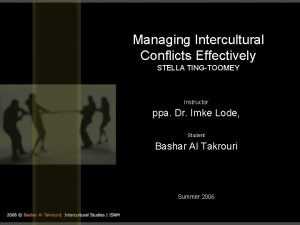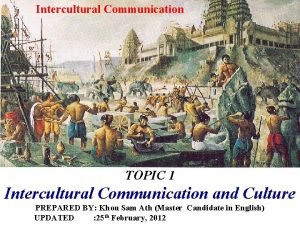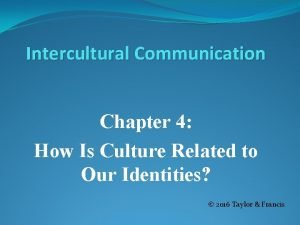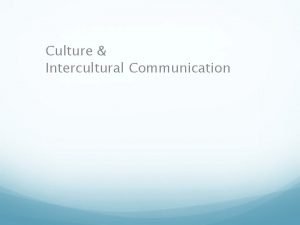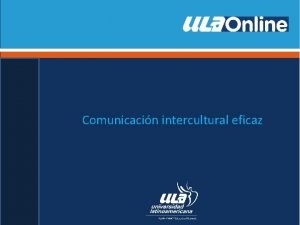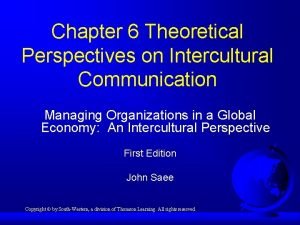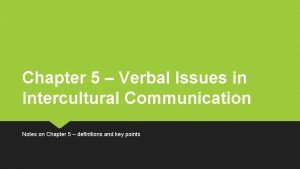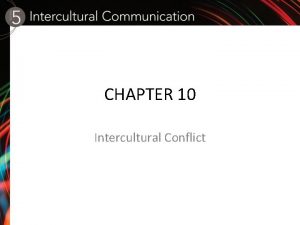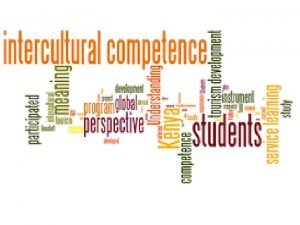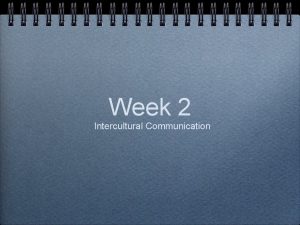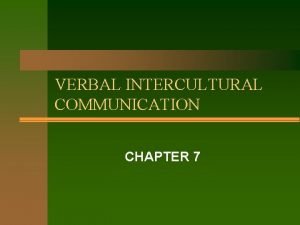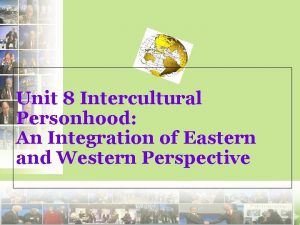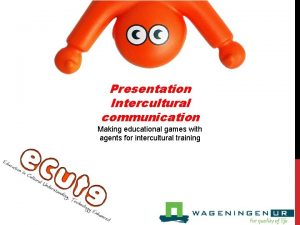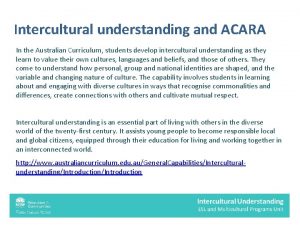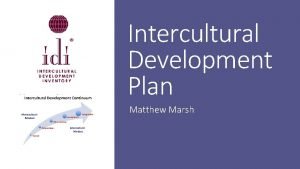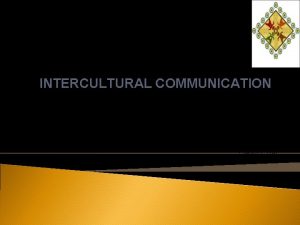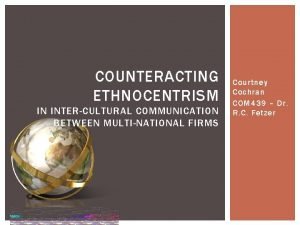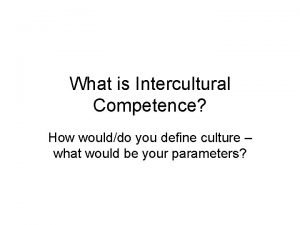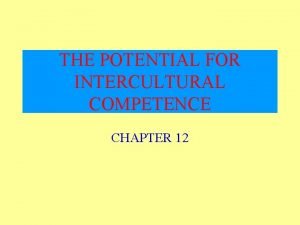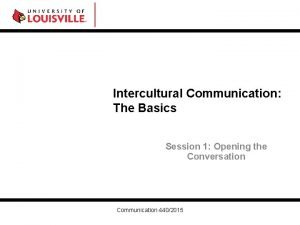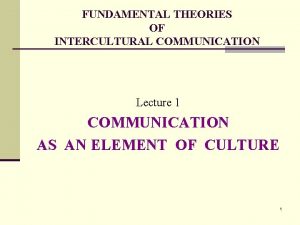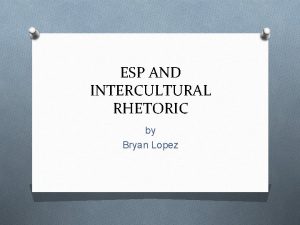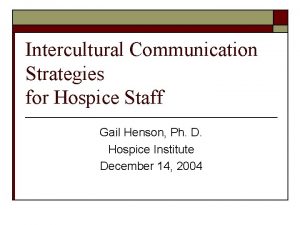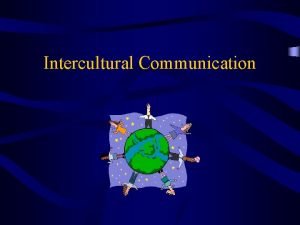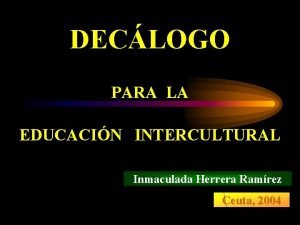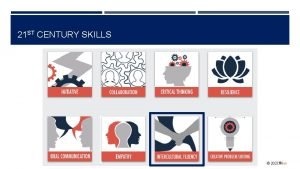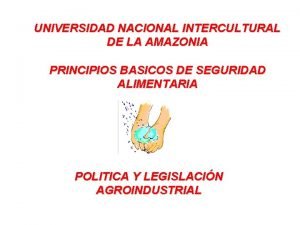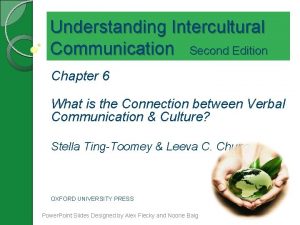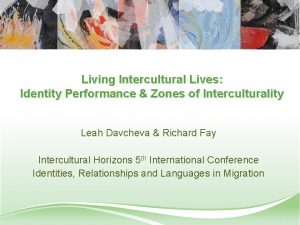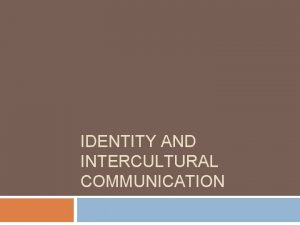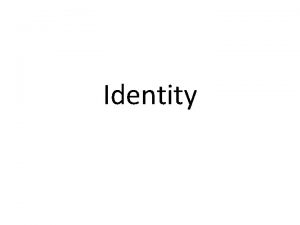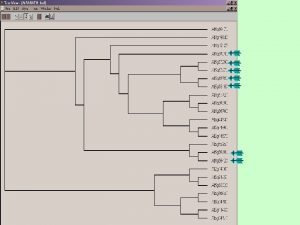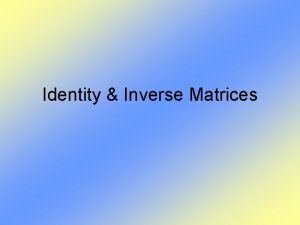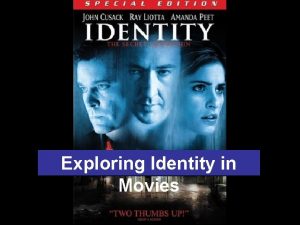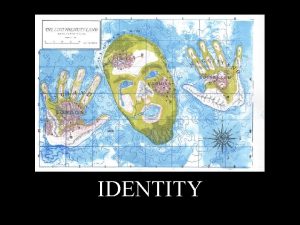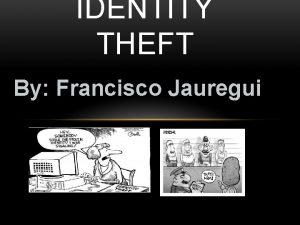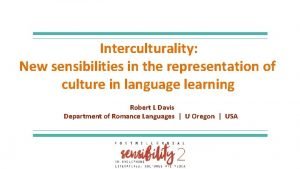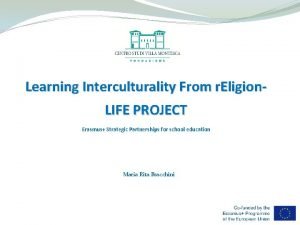Living Intercultural Lives Identity Performance Zones of Interculturality





























![The domestic zone (3) … my Grandma moved in with us. […] She could The domestic zone (3) … my Grandma moved in with us. […] She could](https://slidetodoc.com/presentation_image_h/9b25b8f37d605fa3369f79b97bfba145/image-30.jpg)















- Slides: 45

Living Intercultural Lives: Identity Performance & Zones of Interculturality Leah Davcheva & Richard Fay University of Sofia 9 th November 2015 1

April 1492 2

Migrations and settlements 3

Ladino – heritage language of the Sephardim Names: Judesmo, Judaeo-Spanish, Spanyol, etc. A Romance language with roots in mediaeval Spanish Elements from: * Hebrew and Aramaic, reflecting its function as a Jewish language * French (via schooling) * Arabic, Turkish, Greek, Bulgarian (co- territorial status in the Ottoman Empire) Has played an important cultural and communicational role for Sephardic Jewish communities 4

Elias Canetti wrote: People of the most varied backgrounds lived there, on any one day you could here seven or eight languages. […] Through the centuries since their expulsion from Spain, the Spanish they spoke with one another has changed little. A few Turkish words had been absorbed, but they were recognisable as Turkish, and there were nearly always Spanish words for them. The first children’s songs I heard were Spanish, I heard old Spanish romances; but the thing that was most powerful was a Spanish attitude. [. . . ] To each other, my parents spoke German, which I was not allowed to understand. To us children and to all relatives and friends, they spoke Ladino. That was the true vernacular, albeit an ancient Spanish, I often heard it later on and I’ve never forgotten it. . All events of those first few years were in Ladino or Bulgarian. It wasn’t until much later that most of them were rendered into German within me. (1979: 10) 5

Yasmin Levy’s sings …. No tengo lugar I have no place Y no tengo paisaje And I have no landscapes Yo enos tengo patria I have no homeland ‘Naci en Alamo’, from the album La Juderia by Yasmin Levy © 2005, Adama Music 6

The story of our interest in Ladino Richard and a calendar Leah and her Dad desire to do more collaborative narrative research outside a formal setting 7

The story of developing the project • moving from intent to action • identifying possible participants/storytellers - speaking to personal contacts - gaining access to the Ladino club (gatekeepers) • getting them to agree – how? • setting up the interviews / narrative encounters 8

The story of developing the project language choices in the field and in the project reciprocal reflexivity + researcher stories data corpus issues of transcription and translation double analysis and restorying move from oral history to intercultural conceptualisation multilingual and multi-audience representations 9

Meet our storytellers chosen for their knowledge of Ladino unexceptional, ordinary people not particularly special vis-à-vis intercultural communication having lived their lives in a complex and diverse society 10

Ivet Anavi 11

Eli Anavi 12

Claire Levy 13

David Cohen 14

Reina Lidgi 15

Aron Balli 16

Solomon Balli 17

Samuel Frances 18

Itsko Finzi 19



Restoried narrative in English My grandparents When I was a child, there was the sound of this language all around me. We lived with my maternal grandparents, and they spoke Spanyol to me. The moment the door of our house shut the street off behind me, Spanyol was on. My grandfather spoke it beautifully. He also had a big collection of books in Spanyol and had read them all. Or take my paternal grandma Lisa – she had brought back books from her trips to Plovdiv and Istanbul. These were small books, beautifully bound. Grandma herself was very small but intellectually very sharp. 22

Restoried narrative in English Hide-and-seek I did not understand much at first. Sometimes it so happened that the elders did not want us, the children, to understand what they were talking about. And they would say it in Spanyol. I know that you, as a child, were also frustrated when you were left out of this language hide-and-seek. I remember experiencing the same feelings but I would say to my sister, “You should learn Spanish!” She was older than me and I kept saying to her that she had the responsibility, being the elder sister, to learn Spanish, so that we could understand what our grandparents were hiding from us. Sometimes they wanted to go out for the evening and would put me to bed early. I really hated that. Other times, my Grandma wanted to go and see friends, and she did not want me with her. All of this was communicated in Spanyol, so that I could not catch the details and prepare to resist the injustice. 23

Insights the intra-, inter- and trans-cultural activities that the members of the diasporic Sephardic community in Bulgaria have engaged in and continue to engage in drawing upon their resources in Ladino interactions enabled by their multilingualism and especially their main language of cultural affiliation – Ladino interactions within and beyond their home society in Bulgaria and beyond 24

Main research outcome: five zones of interculturality the (intra-)personal --- a zone of internal dialogue; the domestic --- a zone for the family the local --- a zone for the Sephardic community in Bulgaria; the diasporic --- a zone for the wider Sephardic community; & the international --- the international community of Spanishusers. As set against the historically-, politically-, culturally-, and societally- changing Bulgarian Sephardic Jewish Ladinooriented context(s) 25

The (Intra-)Personal zone (1) … the way I felt exceptional when I realised that I knew a language which was not typically spoken in Bulgaria. [Aron] My sense of being an heir to this language is special. It enthuses and empowers me with a kind of primary and fundamental force … We seek our sense of uniqueness and find it in this language. It is a symbol, a token of our otherness. [Andrey] 26

The (Intra-)Personal zone (2) Ladino gives me a sense of belonging to something larger. Every so often, it gives me the freedom of choice – I can choose the culture I want to belong to. Even though it is not the language that I use now it just pops up in certain situations and this makes me realise that there’s this language inside me, lurking there, deep inside. [Gredi] I sometimes wonder about my [Ladino] accent or my intonation – perhaps they bear some Jewish traces and give me away. [Andrey] 27

The domestic zone (1) Judesmo is my mother tongue. At home we spoke Judesmo. I spoke Judesmo with my aunts, grannies, everybody … [Ivet] We lived with my maternal grandparents, Grandad Gershon and Grandma Rachel. They spoke to me in Spanyol [Ladino] but I didn’t understand much at first. [Gredi] My grandma would always speak to me in Spanish [Ladino]. [Andrey] 28

The domestic zone (2) My Grandma always spoke to me in Ladino. When I was in my teens and my friends were around, she would still do it. She very well knew that my friends were all Bulgarian and could not understand a single Ladino word. Invariably, my reaction was to respond to her in Bulgarian, and thus demonstrate my disapproval – emphatically and strongly. This kind of response destroyed the intimacy between us. We would often argue. [Andrey] 29
![The domestic zone 3 my Grandma moved in with us She could The domestic zone (3) … my Grandma moved in with us. […] She could](https://slidetodoc.com/presentation_image_h/9b25b8f37d605fa3369f79b97bfba145/image-30.jpg)
The domestic zone (3) … my Grandma moved in with us. […] She could not speak Bulgarian and she took it upon herself to teach me Ladino. She must have been a good ‘teacher’ … in less than three months, I was able to communicate with her in Ladino. I don’t think I could fully understand everything but we somehow managed to talk with each other. [Reina] Our domestic help were Bulgarian girls and we spoke Bulgarian with them. [Ivet] In the years when the first socialist government came into power … gradually Judesmo [Ladino] stopped being the language of my family. During socialism, we did not speak Judesmo. [Ivet] 30

The local zone of the Sephardim in Bulgaria (1) In Plovdiv, my father used to go to the Jewish club every day. He played cards with his friends. All their jokes, curses and playful bantering were done in Judesmo. [Eli] When she was young, my paternal Grandma Blanca regarded herself a modern young woman and tended to speak Bulgarian only. In those times, they apparently believed that speaking Ladino was something that only the lower classes did, or just old women anyway. Competence in correctly spoken literary Bulgarian was very highly valued. [Andrey]. 31

The local zone of the Sephardim in Bulgaria (2) A terrible pressure for integration was exerted, both from the inside and from the outside. I grew up in the Jewish neighbourhood where we spoke Bulgarian with a distinctive accent. […. ] We did not like sticking out like this and did our best to get rid of the accent - so that nobody could tell. [Aron] When I started singing in the Dulce Canto choir we sang Ladino songs there and I felt I was able ‘to hear’ this language and identify with it. [Solomon] Ladino is like a live coal hidden among the ashes [Aron] 32

The ‘diasporic’ zone of the wide Sephardic community (1) We became ‘Bulgarian Jews’ only 70 -80 years ago. Before that we used to be Balkan Jews. Should we find ourselves among Jews from other Balkan countries, there would hardly be anything to make us inherently different from each other – except for the language our passports have been written in. We do things in similar ways. Everywhere on the Balkans I feel at home. [Solomon] 33

The ‘diasporic’ zone of the wide Sephardic community (2) I do business with people from Istanbul, in Turkey […] Half of my communication goes in Turkish, the other half – in Spanyol. [Aron] In Jerusalem, I set out to see the Holocaust museum. As it was closed I wanted to find out about the working hours and came across a man from Egypt who spoke Spanyol. When we finished talking he said to me, “If you walk a bit further, you’ll find another guy who can also speak Spanyol. ” [Sami] 34

The ‘diasporic’ zone of the wide Sephardic community (3) At this event, I had the chance to speak Ladino with the ex-president of Israel, Yitzhak Navon himself was born in Israel but, in his family, Ladino had been spoken for centuries. He was Chair of the Sephardic Institute in Israel. We communicated in Ladino and understood each other perfectly well. There were differences in the way we spoke it but this didn’t surprise me. Over the centuries, Spanyol had absorbed features from many other languages. [Sami] 35

The ‘diasporic’ zone of the wide Sephardic community (4) • I’ve come across people from other Sephardic communities […] I met a Jewish guy from Cuba once. We spoke and our conversation resonated with something deep inside me and we both felt we belonged together. [Solomon] … my paternal grandma Lisa – she had so many books in Spanyol; she used to buy these books in Plovdiv, but also in Istanbul, and bring them back with her. Small books, beautifully bound, linking us together [Gredi] 36

The international community of Spanish speakers (1) I remember my first visit to Spain, quite an emotional experience. I felt completely comfortable in the Spanish speaking context and was pleasantly excited by listening to the people around me and being able to understand. Away from home and my own country, I still had this amazing sense of being in a linguistically familiar context. I said the last couple of sentences of my presentation in Judaesmo. Espanyol. It may have all sounded ridiculous and primitive because I had never specially studied Judaesmo, but it was received well. People applauded me. … I felt at home and an insider. [Eli] 37

The international community of Spanish speakers (2) Have you ever heard Cubans speak Spanish? They tend to swallow their consonants and it’s hard to understand them. For a whole week I kept my mouth shut and did not dare speak. By and by, I gathered courage and would put in a Ladino word here and a word there. […] The the response of the Cubans was twofold. First, they thought they heard somebody who had risen from their grave. So obsolete was the language I produced. They were enormously delighted and would make me repeat what I said, time and time again. [Aron] 38

The international community of Spanish speakers (3) I expressed myself by capturing the root of a word and then attached different things to it. The result was a mongrel-like language, a mixture of everything. But I managed to get around through this approximation of the Spanish language. [Gredi] I bought myself a Spanish textbook. In Sofia, I became friends with a man from Cuba and learned a lot of Spanish words from him. When I write email messages to my friends, I try to write them in Spanish. My vocabulary has increased and I make efforts to use the correct words. [Itsko] 39

The international community of Spanish speakers (4) When we first met, I spoke to her in Ladino. I was amazed that Reyes could understand what I was saying and importantly, I could understand her too. [Reina] […] was keen to hear the language which he had never heard anybody speak before. The time we spent together made me aware of the special attitude the Spanish have for us, Sephardic Jews: they find it truly amazing that not only have we preserved Ladino for five centuries but we also cherish the warmest sentiments for Spain itself. [Reina] 40

The story of our conceptual model evolving as a by-product of our main focus on the storytellers’ narrativised understandings of Ladino developed inductively rather than framed in existing models of ICC shared set of ways of working with and understanding the intercultural a prior initial attempt to work with zones of interculturality a sense of identity work through narration 41

The model: Zones of Interculturality 42

Zones of interculturality from the most personal to the most global increasing or decreasing the number of zones fluidity between the zones the langua-cultural resources of the participants work in progress 43

An invitation to engage with narrative methodology choosing a narrative hook narrative experience 1 narrative experience 2 small group reflection on experience plenary discussion 44

An invitation to engage with narrative methodology • Bearing in mind what you’ve heard about narrative methodology and who your neighbour is today What brief story would you like them to tell you? • Begin like this, for example: I am really interested in the story of your previous contact with Jewish cultures… 45
 Temperate climate zone for kids
Temperate climate zone for kids How do littoral zones differ from riparian zones?
How do littoral zones differ from riparian zones? Social identity map
Social identity map Difference between living and non living organisms
Difference between living and non living organisms Is moss living or nonliving
Is moss living or nonliving Living non living dead
Living non living dead Smallest living unit
Smallest living unit Intercultural barriers to communication
Intercultural barriers to communication Managing intercultural conflict effectively
Managing intercultural conflict effectively Intercultural fluency
Intercultural fluency Kim's model of intercultural conflict
Kim's model of intercultural conflict Example of a low context culture
Example of a low context culture Questions about intercultural communication
Questions about intercultural communication Avowal intercultural communication
Avowal intercultural communication Intercultural communication meaning
Intercultural communication meaning Comunicación intercultural eficaz
Comunicación intercultural eficaz Kincaid's convergence model of communication example
Kincaid's convergence model of communication example Intercultural communication notes
Intercultural communication notes Kim's model of intercultural conflict
Kim's model of intercultural conflict Interculturally competent meaning
Interculturally competent meaning Staircase model of intercultural communication
Staircase model of intercultural communication Example of verbal intercultural communication
Example of verbal intercultural communication Intercultural personhood definition
Intercultural personhood definition Intercultural
Intercultural Nonverbal communication codes
Nonverbal communication codes Acara intercultural understanding
Acara intercultural understanding Intercultural development plan
Intercultural development plan Intercultural development continuum
Intercultural development continuum Intercultural communication conclusion
Intercultural communication conclusion Intercultural travel
Intercultural travel Ethnocentrism intercultural communication
Ethnocentrism intercultural communication Define intercultural competence
Define intercultural competence Behavioral assessment scale for intercultural competence
Behavioral assessment scale for intercultural competence Culture as a resource
Culture as a resource Intercultural communication model
Intercultural communication model Intercultural capability vic curriculum
Intercultural capability vic curriculum Technology and intercultural communication
Technology and intercultural communication The totality of a groups thought experiences and patterns
The totality of a groups thought experiences and patterns Intercultural rhetoric examples
Intercultural rhetoric examples Strategies for improving intercultural communication
Strategies for improving intercultural communication Competent intercultural communicators resist ambiguity.
Competent intercultural communicators resist ambiguity. Risco intercultural
Risco intercultural Decálogo para una educación intercultural
Decálogo para una educación intercultural Intercultural fluency
Intercultural fluency Universidad nacional intercultural de la amazonía
Universidad nacional intercultural de la amazonía Intercultural communication 2nd edition
Intercultural communication 2nd edition








